Multidimensional Assessment of the Aesthetic Quality of Natural Landscapes in Mount Wuyi National Park, China
Abstract
1. Introduction
2. Research Framework and Methods
2.1. Research Framework: Key Dimensions of Aesthetic Quality in Natural Landscapes
2.2. Study Area
2.3. Dataset and Pre-Processing
2.4. Methods
2.4.1. Identification Methods for Individual and Combined Natural Landscapes
- (1)
- The fishnet tool in ArcGIS 10.6 was employed to construct spatial base units of 100 m × 100 m based on previous studies [26,27] and the area of the study region (1279.82 km2). Each grid cell was uniquely coded to facilitate the extraction of constituent elements of the combined natural landscapes for subsequent analysis.
- (2)
- According to the studies by Warnock et al. and Castillo-Rodríguez et al. [28,29], and considering the characteristics of the study area, land cover, vegetation, topography, and geomorphology were selected as the fundamental elements for delineating combined natural landscapes (Table 2). These data were integrated into the pre-established spatial grid cells using ArcGIS 10.6 software. The k-means clustering method [25], which is suitable for large-scale sample analysis, was employed to categorize combined natural landscape types initially.
- (3)
- The initial boundaries of the combined natural landscapes were spatially visualized using ArcGIS 10.6 software. Subsequently, the same type of grid units was spatially merged and smoothed to determine the initial boundaries of natural landscape character areas. Additionally, the characteristics of each type of combined natural landscape were described.
- (4)
- Integrating satellite remote sensing image data with field survey data, a holistic approach was employed to manually adjust and refine the boundaries of the combined natural landscape formed in the previous step. Emphasis was placed on categorizing vegetation landscapes into finer types, merging landscapes that were too small in area and fragile water landscapes, and other measures to achieve a refined processing of the combined natural landscape boundaries. This process established the final combined natural landscapes with distinct natural geographic attributes.
2.4.2. Evaluation of Aesthetic Quality of Individual and Combined Natural Landscapes
3. Results
3.1. Identification and Spatial Analysis of Individual and Combined Natural Landscapes
3.1.1. Spatial Distribution Characteristics of Individual Natural Landscapes
3.1.2. Boundaries and Spatial Characteristics of Combined Natural Landscapes
3.2. Aesthetic Quality Analysis of Individual and Combined Natural Landscapes
3.3. Comprehensive Analysis of the Aesthetic Quality of Natural Landscapes
4. Discussion and Limitations
4.1. Discussion
4.2. Limitations and Future Perspectives
5. Conclusions
Supplementary Materials
Author Contributions
Funding
Data Availability Statement
Conflicts of Interest
References
- Tatum, K.; Porter, N.; Hale, J. A feeling for what’s best: Landscape aesthetics and notions of appropriate residential architecture in Dartmoor National Park, England. J. Rural. Stud. 2017, 56, 167–179. [Google Scholar] [CrossRef]
- He, S.Y.; Su, Y.; Min, Q.W. Boundary, zoning, and land use management of the China National Parks: Learning from Nature Reserves and Scenic Areas. Acta Ecol. Sin. 2019, 29, 1318–1329. (In Chinese) [Google Scholar]
- Wang, Q.; Wu, Y.G.; Ren, M.X.; Li, B.L. Suggestions on optimizing the planning of national parks and national nature reserves in China. Sci. Technol. Rev. 2023, 41, 14–20. (In Chinese) [Google Scholar]
- Nowak-Olejnik, A.; Schirpke, U.; Tappeiner, U. A systematic review on subjective well-being benefits associated with cultural ecosystem services. Ecosyst. Serv. 2022, 57, 101467. [Google Scholar] [CrossRef]
- Cheng, X. A Review of Empirical Studies of Cultural Ecosystem Services in National Parks: Current Status and Future Research. Land 2023, 12, 1912. [Google Scholar] [CrossRef]
- Schirpke, U.; Zoderer, B.M.; Tappeiner, U.; Tasser, E. Effects of past landscape changes on aesthetic landscape values in the European Alps. Landsc. Urban Plan. 2021, 212, 104109. [Google Scholar] [CrossRef]
- Zube, E.H. Perceived land use patterns and landscape values. Landsc. Ecol. 1987, 1, 37–45. [Google Scholar] [CrossRef]
- Huang, Y.; Zhao, Z.B.; Zhang, C.; Chen, Y. Spatial constitution and group differences in landscape values in the tourism community. Tour. Trib. 2016, 31, 80–90. (In Chinese) [Google Scholar]
- Gine, D.S.; Albert, M.Y.P.; Buendia, A.V.P. Aesthetic assessment of the landscape using psychophysical and psychological models: Comparative analysis in a protected natural area. Landsc. Urban Plan. 2021, 214, 104197. [Google Scholar] [CrossRef]
- Tveit, M.; Ode, Å.; Fry, G. Key concepts in a framework for analysing visual landscape character. Landsc. Res. 2006, 31, 229–255. [Google Scholar] [CrossRef]
- Ode, A.; Tveit, M.S.; Fry, G. Capturing landscape visual character using indicators: Touching base with landscape aesthetic theory. Landsc. Res. 2008, 33, 89–117. [Google Scholar] [CrossRef]
- Hermes, J.; Albert, C.; von Haaren, C. Assessing the aesthetic quality of landscapes in Germany. Ecosyst. Serv. 2018, 31, 296–307. [Google Scholar] [CrossRef]
- Kalinauskas, M.; Miksa, K.; Inacio, M.; Gomes, E.; Pereira, P. Mapping and assessment of landscape aesthetic quality in Lithuania. J. Environ. Manag. 2021, 286, 112239. [Google Scholar] [CrossRef]
- Hou, Y.Z.; Zhao, W.W.; Hua, T.; Pereira, P. Mapping and assessment of recreation services in Qinghai-Tibet Plateau. Sci. Total Environ. 2022, 838, 156432. [Google Scholar] [CrossRef]
- Solecka, I.; Rinne, T.; Martins, R.C.; Kytta, M.; Albert, C. Important places in landscape—Investigating the determinants of perceived landscape value in the suburban area of Wrocław, Poland. Landsc. Urban Plan. 2022, 218, 104289. [Google Scholar] [CrossRef]
- Zhou, N.X.; Huang, Z.F.; Jiang, M.P.; Liang, Y.Y. The relationships between forest landscape visual quality and landscape spatial pattern index of Mount Lushan. Geogr. Res. 2012, 31, 1224–1232. (In Chinese) [Google Scholar]
- Xu, L.L.; Yu, H. Research progress of international landscape evaluation, protection, and utilization of national parks and implications to China. Resour. Sci. 2022, 44, 1520–1532. (In Chinese) [Google Scholar] [CrossRef]
- Wang, P.; Yang, W.J.; Wang, D.J.; He, Y.J. Insights into Public Visual Behaviors through Eye-Tracking Tests: A Study Based on National Park System Pilot Area Landscapes. Land 2021, 10, 497. [Google Scholar] [CrossRef]
- Liu, H.C.; Sun, Z.R.; Wu, J.Y.; Yu, H.; Yang, X.M.; Zhou, D.J. Evaluation of natural landscape aesthetic value and its spatial differentiation in Tibet from the perspective of ecosystem services. Prog. Geogr. 2023, 42, 1961–1972. (In Chinese) [Google Scholar] [CrossRef]
- Du, A.; Xu, W.H.; Xiao, Y.; Cui, T.; Song, T.Y.; Ouyang, Z.Y. Evaluation of Prioritized Natural Landscape Conservation Areas for National Park Planning in China. Sustainability 2020, 12, 1840. [Google Scholar] [CrossRef]
- LY/T 3189-2020; National Park Resource Survey and Evaluation Norms. National Forestry and Grassland Administration: Beijing, China, 2020.
- Albaladejo-García, J.A.; Zabala, J.A.; Alcon, F.; Dallimer, M.; Martínez-Paz, J.M. Integrating socio-spatial preference heterogeneity into the assessment of the aesthetic quality of a Mediterranean agricultural landscape. Landsc. Urban Plan. 2023, 239, 104846. [Google Scholar] [CrossRef]
- Yuan, S.; Browning, M.H.E.M.; McAnirlin, O.; Sindelar, K.; Shin, S.; Drong, G.; Hoptman, D.; Heller, W. A virtual reality investigation of factors influencing landscape preferences: Natural elements, emotions, and media creation. Landsc. Urban Plan. 2023, 230, 104616. [Google Scholar] [CrossRef]
- Pantano, E.; Scarpi, D.; Vannucci, V.; Bilotta, E.; Pantano, P. Probability-density risk-maps for tourism during emergencies. Ann. Tour. Res. 2022, 92, 103259. [Google Scholar] [CrossRef]
- Van Eetvelde, V.; Antrop, M. A stepwise multi-scaled landscape typology and characterisation for trans-regional integration, applied on the federal state of Belgium. Landsc. Urban Plan. 2009, 91, 160–170. [Google Scholar] [CrossRef]
- Yang, D.C.; Gao, C.; Li, L.Y.; Van Eetvelde, V. Multi-scaled identification of landscape character types and areas in Lushan National Park and its fringes, China. Landsc. Urban Plan. 2020, 201, 103844. [Google Scholar] [CrossRef]
- Willemen, L.; Verburg, P.H.; Hein, L.; van Mensvoort, M.E.F. Spatial characterization of landscape functions. Landsc. Urban Plan. 2008, 88, 34–43. [Google Scholar] [CrossRef]
- Warnock, S.; Griffiths, G. Landscape Characterisation: The Living Landscapes Approach in the UK. Landsc. Res. 2015, 40, 261–278. [Google Scholar] [CrossRef]
- Castillo-Rodriguez, M.; Lopez-Blanco, J.; Munoz-Salinas, E. A geomorphologic GIS-multivariate analysis approach to delineate environmental units, a case study of La Malinche volcano (central Mexico). Appl. Geogr. 2010, 30, 629–638. [Google Scholar] [CrossRef]
- Gong, J.; Jin, T.T.; Cao, E.J.; Wang, S.M.; Yan, L.L. Is ecological vulnerability assessment based on the VSD model and AHP-Entropy method useful for loessial forest landscape protection and adaptative management? A case study of Ziwuling Mountain Region, China. Ecol. Indic. 2022, 143, 109379. [Google Scholar] [CrossRef]
- Tang, C.C.; Yang, Y.Y.; Liu, Y.; Xiao, X.Y. Comprehensive evaluation of the cultural inheritance level of tourism-oriented traditional villages: The example of Beijing. Tour. Manag. Perspect. 2023, 48, 101166. [Google Scholar] [CrossRef]
- Hou, G.L.; Huang, Z.F. Evaluation on tourism community participation level based on AHP method with entropy weight. Geogr. Res. 2010, 29, 1802–1813. (In Chinese) [Google Scholar]
- Schirpke, U.; Timmermann, F.; Tappeiner, U.; Tasser, E. Cultural ecosystem services of mountain regions: Modelling the aesthetic value. Ecol. Indic. 2016, 69, 78–90. [Google Scholar] [CrossRef] [PubMed]
- Guo, S.L.; Zhao, N.X.; Zhang, J.X.; Xue, T.; Liu, P.X.; Xu, S.; Xu, D.D. Landscape visual quality assessment based on eye movement: College student eye-tracking experiments on tourism landscape pictures. Resour. Sci. 2017, 39, 1137–1147. (In Chinese) [Google Scholar]
- Simensen, T.; Halvorsen, R.; Erikstad, L. Methods for landscape characterisation and mapping: A systematic review. Land Use Policy 2018, 75, 557–569. [Google Scholar] [CrossRef]
- Bao, Z.T.; Jiang, D.Z.; Zhou, J.Y.; Huang, Y.X. Delineation of spatial units for landscape planning and management based on Landscape Character Assessment (LCA) on territorial scale. Chin. Landsc. Archit. 2023, 39, 46–52. [Google Scholar]

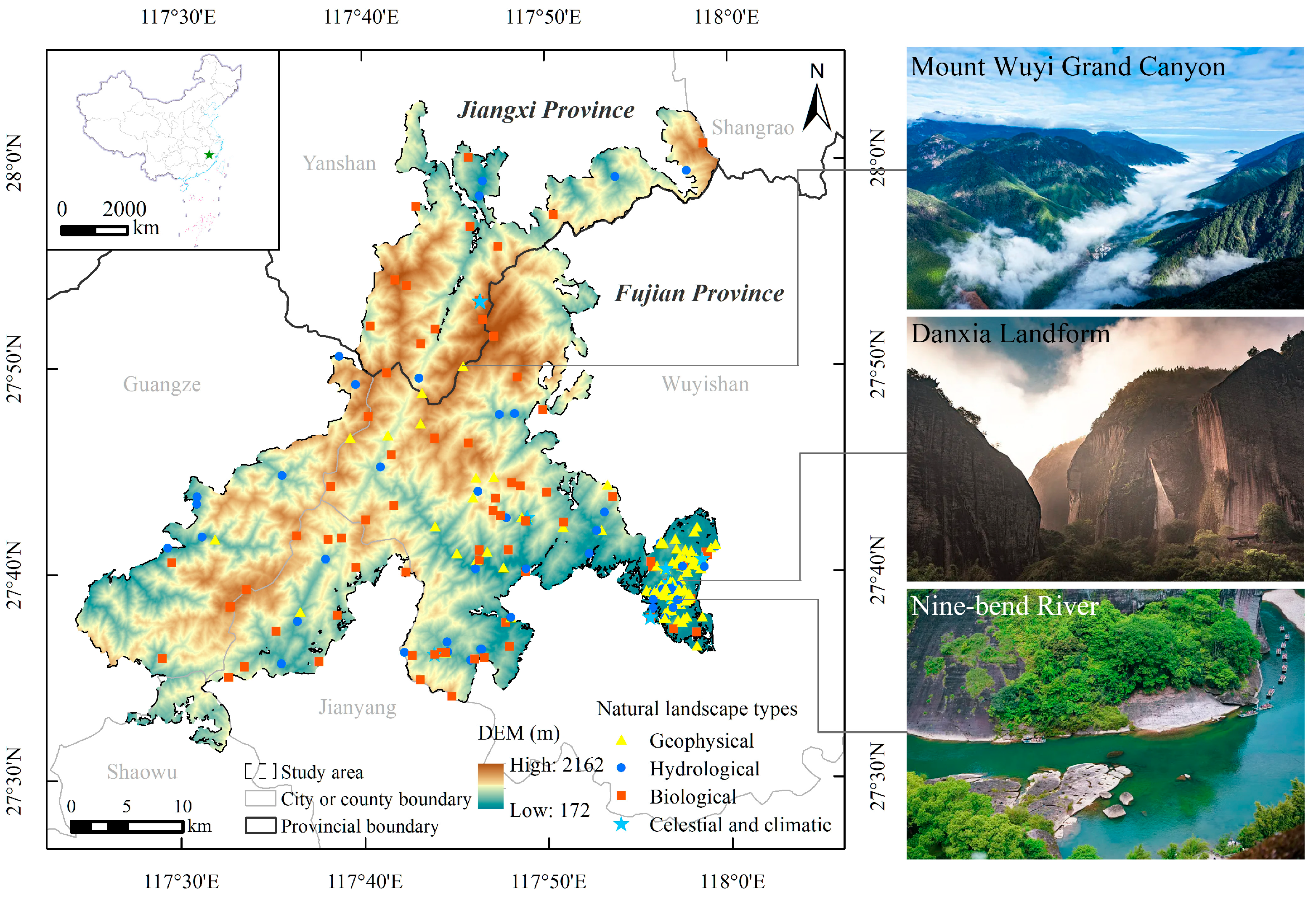
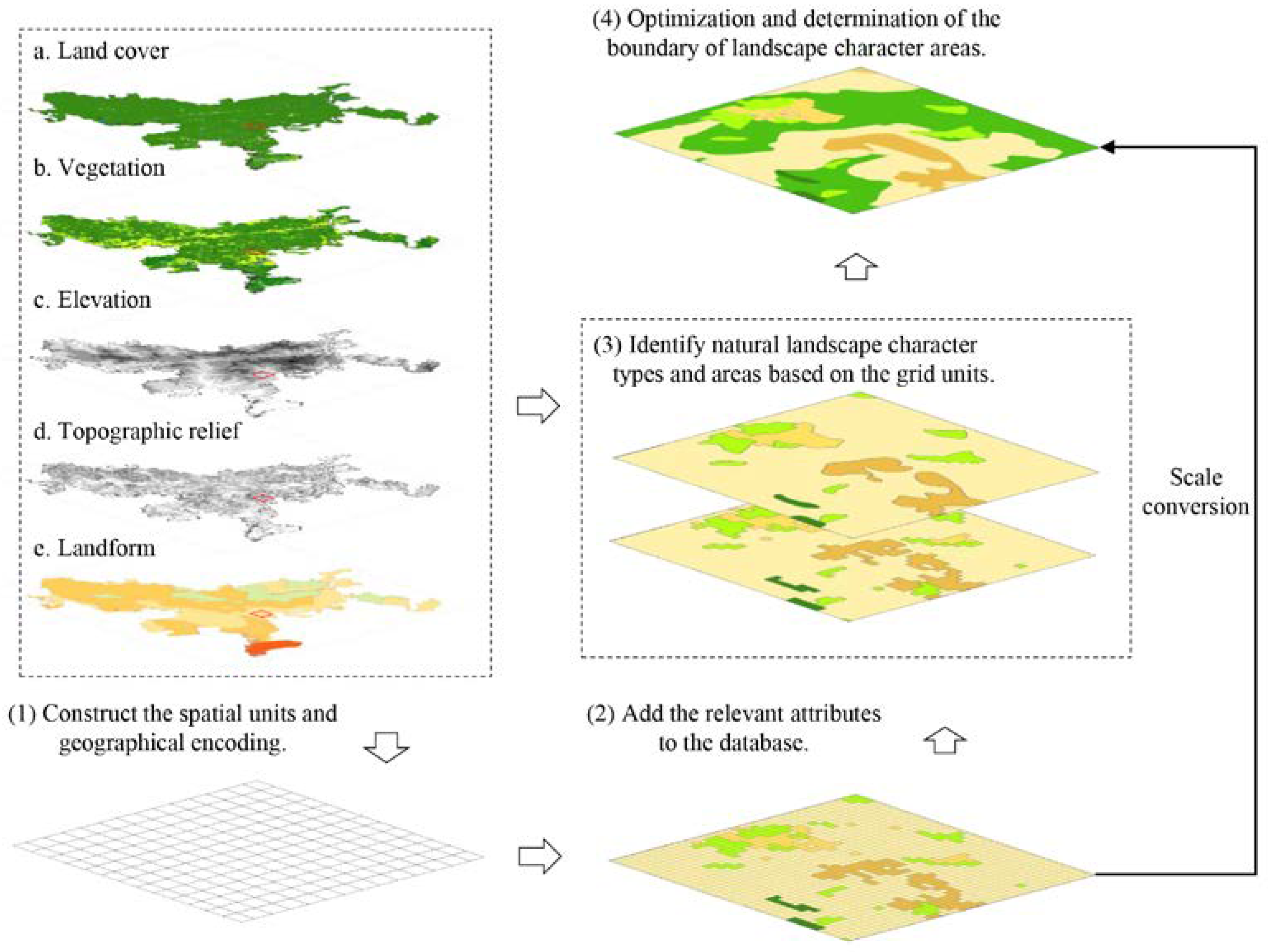
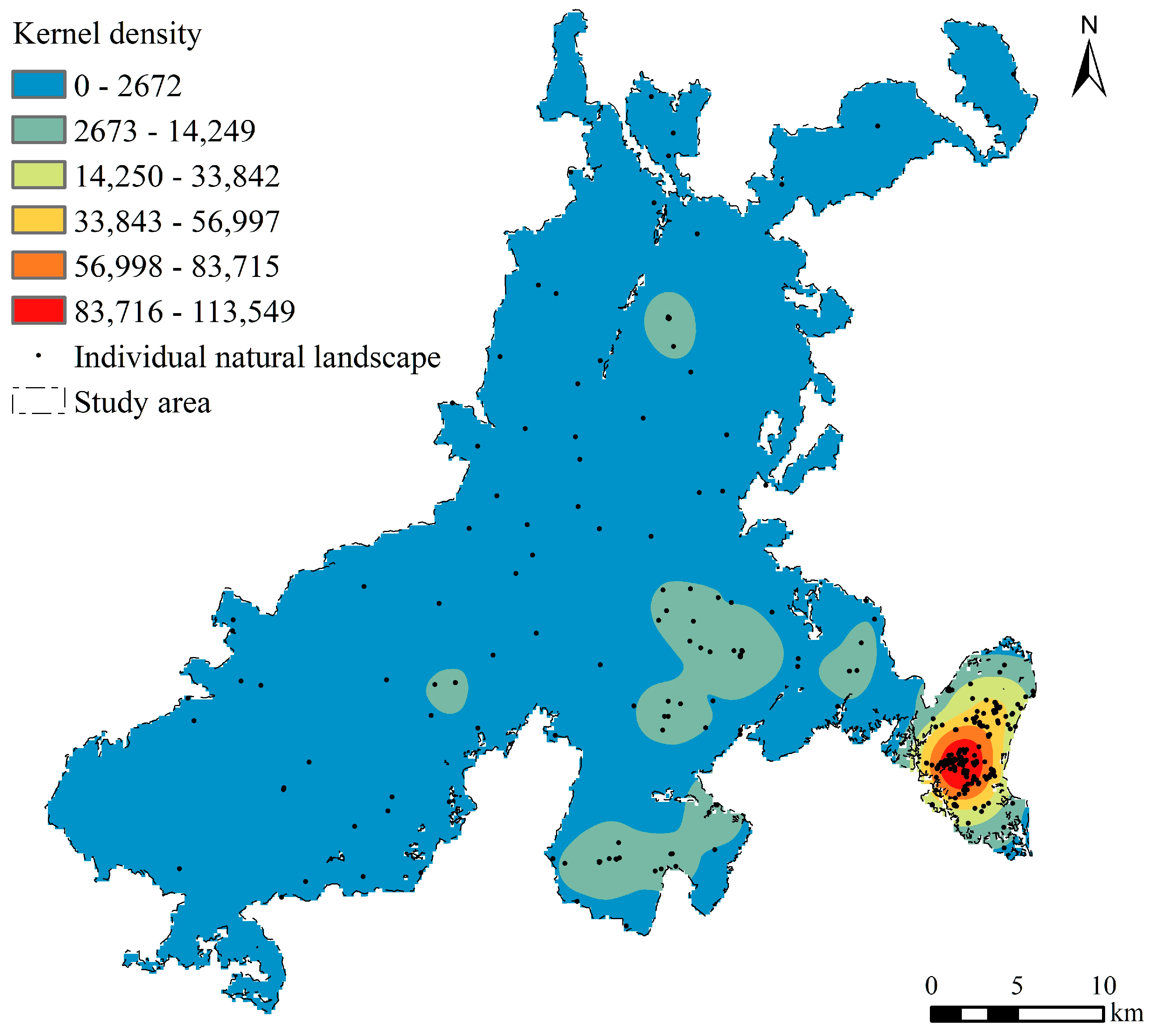
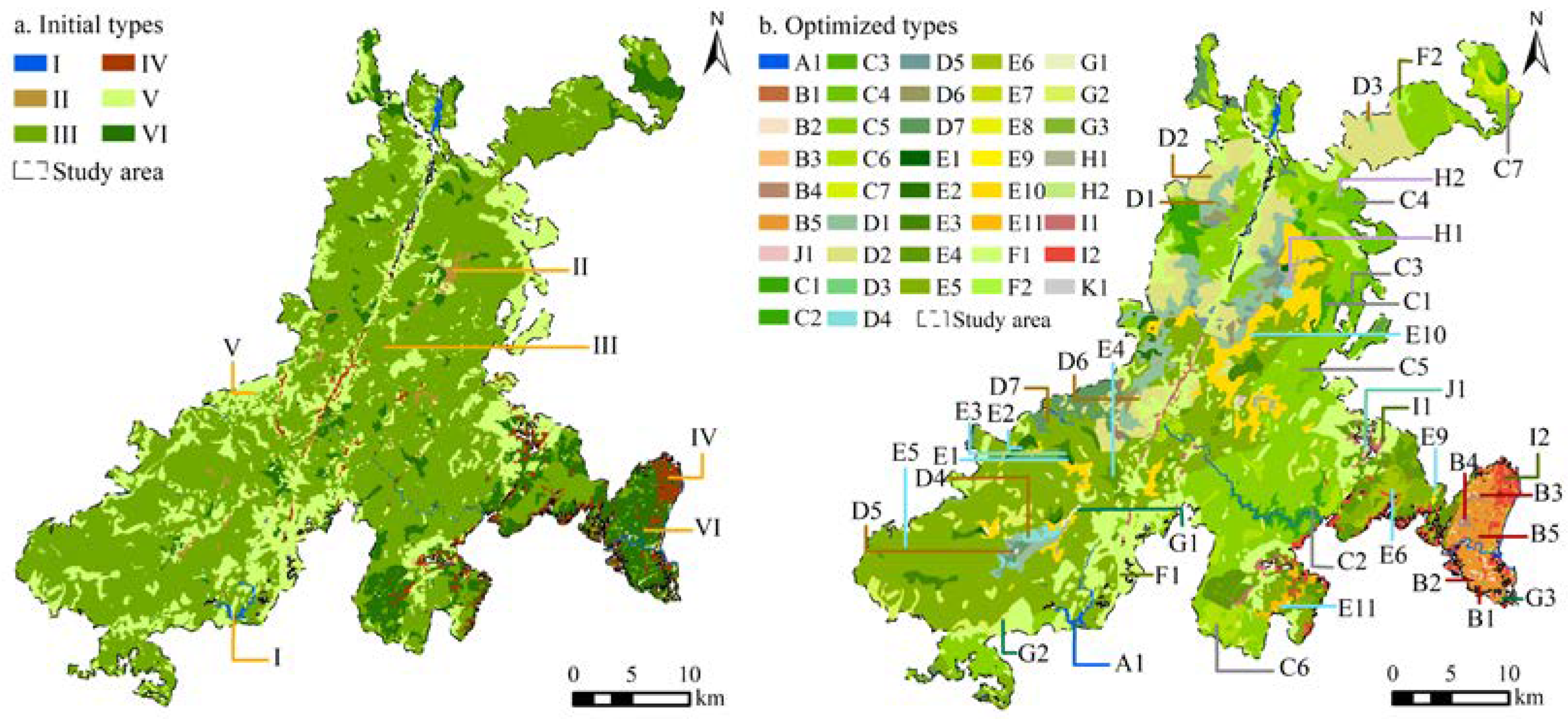
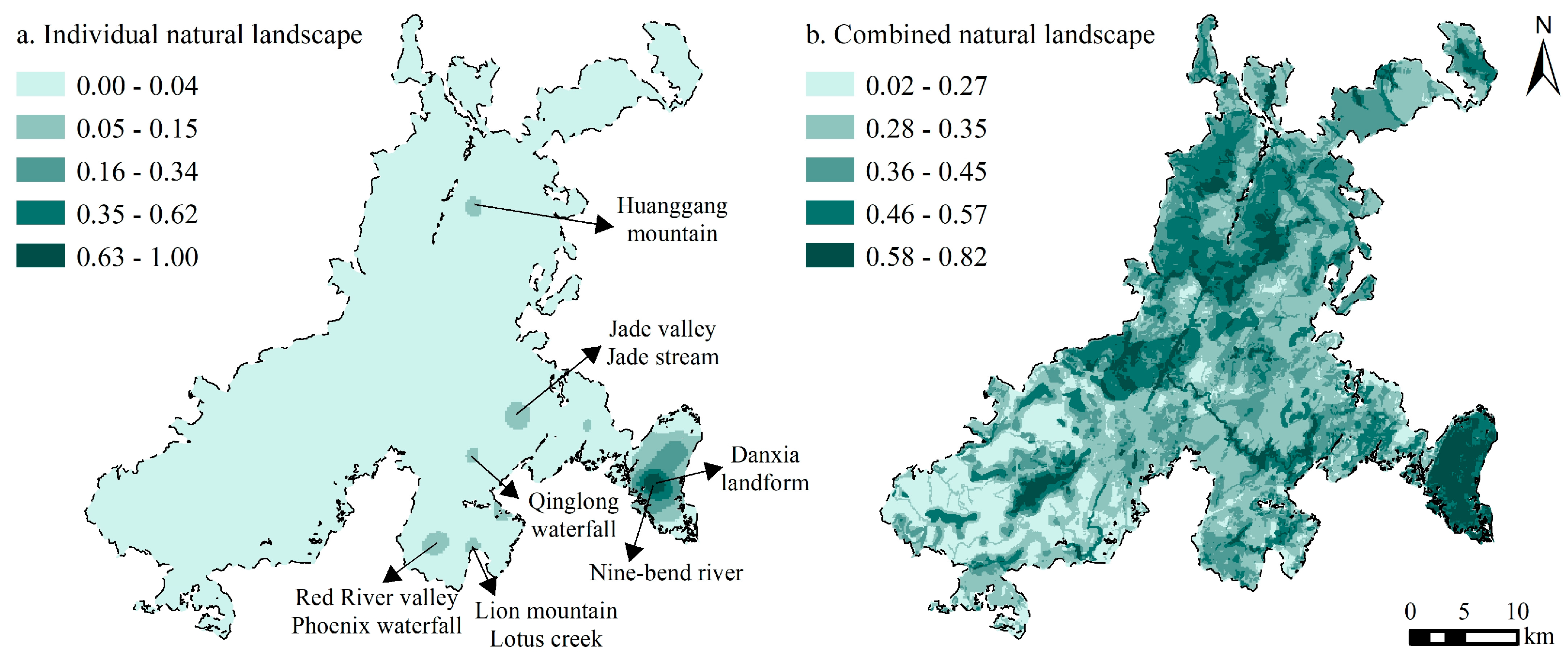
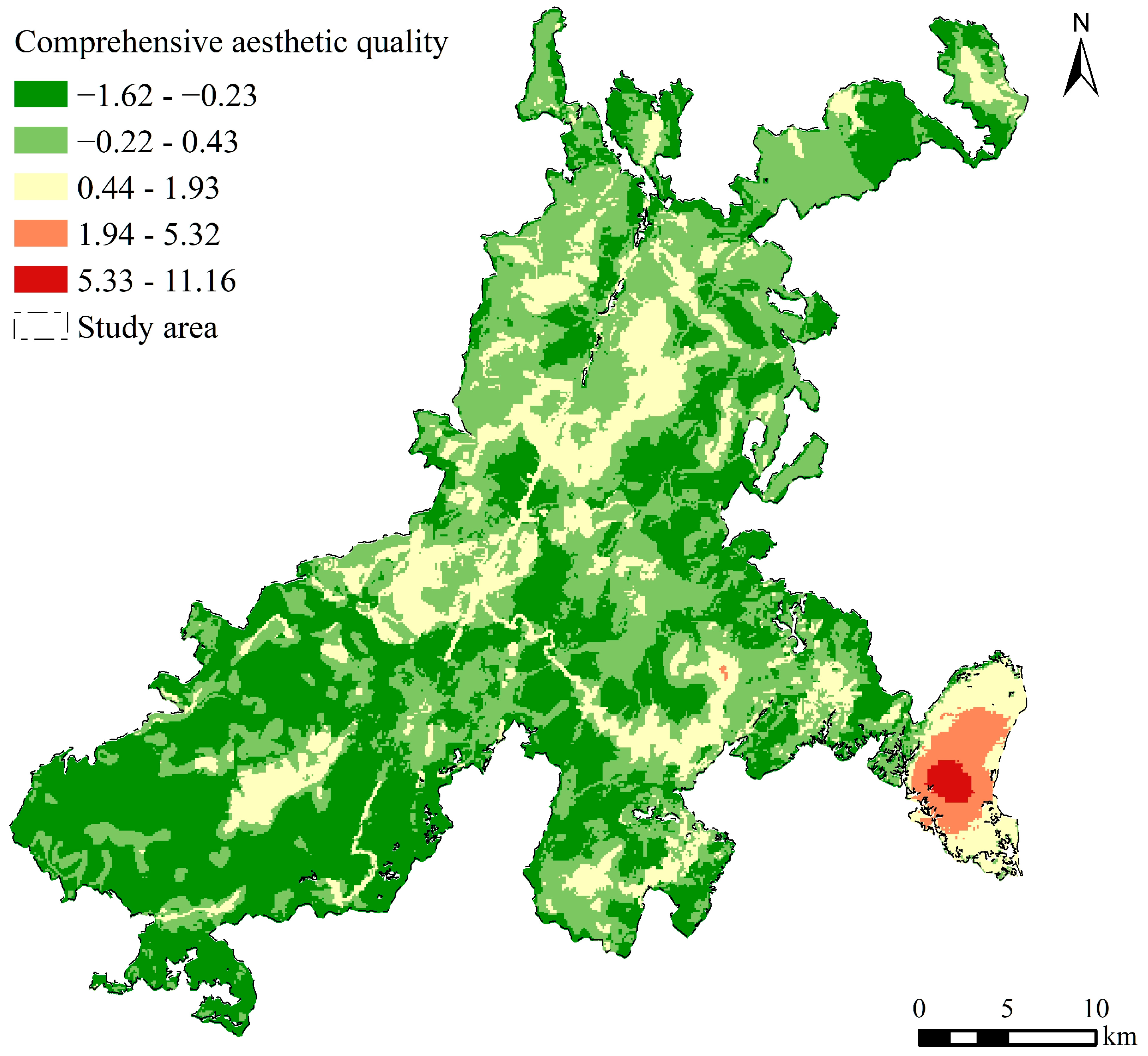
| No. | Dimensions | Connotation | Applicable Scope |
|---|---|---|---|
| 1 | Landscape aesthetic services | The natural characteristics of the landscape, along with the existence of vegetation, water bodies, or distinctive landforms, can offer cultural ecosystem services, such as scenic viewing, recreational experiences, and opportunities for relaxation, to human beings. | Individual and combined natural landscapes |
| 2 | Uniqueness | Uniqueness refers to the distinguishable attributes of a landscape. The landscape possesses a compelling visual representation that imbues it with distinctive qualities and a singular sense of place. | Individual and combined natural landscapes |
| 3 | Diversity | The complexity and changing characteristics of landscapes in both time and space. | Individual and combined natural landscapes |
| 4 | Combination | The quantity abundance and combination characteristics of individual landscape resources. | Individual natural landscapes |
| 5 | Coordination | Coordination refers to the unity and coherence of the landscape, including the degree of visual coordination between landscape elements and between landscape and non-landscape elements. | Combined natural landscapes |
| 6 | Visual scale | The environmental features surrounding the landscape can serve as spatial indicators for individuals to perceive the landscape, including factors such as topography and proximity. | Individual and combined natural landscapes |
| No. | Element Layer | Index Layer |
|---|---|---|
| 1 | Land cover | L1 Orchard |
| 2 | L2 Forest land | |
| 3 | L3 Grassland | |
| 4 | L4 Water | |
| 5 | Vegetation type | V1 Bamboo forest |
| 6 | V2 Coniferous forest | |
| 7 | V3 Broadleaved forest | |
| 8 | V4 Shrubs | |
| 9 | V5 Deciduous broad-leaved mixed forest | |
| 10 | V6 Coniferous and broad-leaved mixed forest | |
| 11 | V7 Meadow | |
| 12 | V8 Artificial economic forest | |
| 13 | Topography | T1 Altitude (m) |
| 14 | T2 Terrain relief | |
| 15 | Landform | G1 Danxia Landform |
| 16 | G2 Volcanic Rock Landform | |
| 17 | G3 Granite Landform | |
| 18 | G4 Clastic Rock Landform |
| No. | Landscape Types | Dimensions | Indicators | |||
|---|---|---|---|---|---|---|
| 1 | Individual landscape | A1 Landscape aesthetic services | AA1 Landscape resource observability | 0.241 | 0.209 | 0.263 |
| 2 | A2 Uniqueness | AA2 Rarity of landscape resources | 0.337 | 0.227 | 0.400 | |
| 3 | AA3 Rarity of landscape resource types | 0.124 | 0.207 | 0.134 | ||
| 4 | A3 Combination | AA4 Combination degree of individual natural landscapes | 0.106 | 0.163 | 0.091 | |
| 5 | A4 Diversity | AA5 Abundance of individual natural landscapes | 0.113 | 0.180 | 0.106 | |
| 6 | A5 Visual scale | AA6 Visual distance | 0.079 | 0.014 | 0.006 | |
| 7 | Combined landscape | A6 Landscape aesthetic services | AA7 Landscape aesthetic service value | 0.271 | 0.027 | 0.099 |
| 8 | A7 Uniqueness | AA8 Uniqueness of landscape characteristics | 0.458 | 0.088 | 0.549 | |
| 9 | A8 Diversity | AA9 Shannon’s diversity index | 0.036 | 0.262 | 0.129 | |
| 10 | AA10 Relative patch richness | 0.035 | 0.121 | 0.058 | ||
| 11 | AA11 Diversity of landscape characteristic types | 0.043 | 0.054 | 0.031 | ||
| 12 | A9 Coordination | AA12 Patch aggregation index | 0.021 | 0.248 | 0.070 | |
| 13 | AA13 Contagion index | 0.018 | 0.058 | 0.014 | ||
| 14 | AA14 Interference degree of road | 0.029 | 0.002 | 0.001 | ||
| 15 | AA15 Interference degree of construction land | 0.038 | 0.000 | 0.000 | ||
| 16 | A10 Visual scale | AA16 Altitude | 0.033 | 0.076 | 0.034 | |
| 17 | AA17 Terrain relief | 0.018 | 0.064 | 0.016 |
Disclaimer/Publisher’s Note: The statements, opinions and data contained in all publications are solely those of the individual author(s) and contributor(s) and not of MDPI and/or the editor(s). MDPI and/or the editor(s) disclaim responsibility for any injury to people or property resulting from any ideas, methods, instructions or products referred to in the content. |
© 2024 by the authors. Licensee MDPI, Basel, Switzerland. This article is an open access article distributed under the terms and conditions of the Creative Commons Attribution (CC BY) license (https://creativecommons.org/licenses/by/4.0/).
Share and Cite
Zheng, X.; Yang, Z.; Lu, Y. Multidimensional Assessment of the Aesthetic Quality of Natural Landscapes in Mount Wuyi National Park, China. Land 2024, 13, 1674. https://doi.org/10.3390/land13101674
Zheng X, Yang Z, Lu Y. Multidimensional Assessment of the Aesthetic Quality of Natural Landscapes in Mount Wuyi National Park, China. Land. 2024; 13(10):1674. https://doi.org/10.3390/land13101674
Chicago/Turabian StyleZheng, Xin, Zhaoping Yang, and Yayan Lu. 2024. "Multidimensional Assessment of the Aesthetic Quality of Natural Landscapes in Mount Wuyi National Park, China" Land 13, no. 10: 1674. https://doi.org/10.3390/land13101674
APA StyleZheng, X., Yang, Z., & Lu, Y. (2024). Multidimensional Assessment of the Aesthetic Quality of Natural Landscapes in Mount Wuyi National Park, China. Land, 13(10), 1674. https://doi.org/10.3390/land13101674






